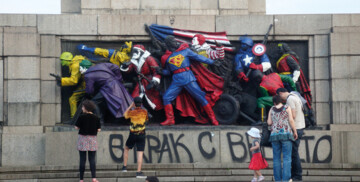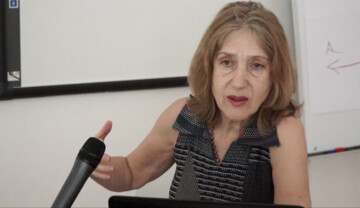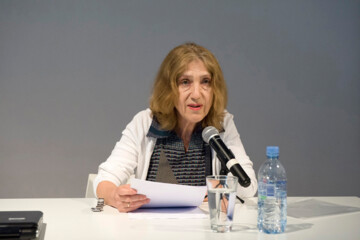
Destructive Creation: In Step with Time, 2011, http://destructivecreation.com/. Courtesy of the artistic collective.
“Heterotopian homonymy” designates a reversal in the meaning of key theoretical and political concepts – and, by extension, of the political implications of artworks – due to geopolitical divisions and the traffic of fantasies of the Other that such divisions involve. Foucault compares heterotopia to a mirror: I gaze at the mirror in order to find out how I look; by returning the gaze the mirror exerts a counter effect; it influences my stance and prompts me to undertake certain actions with regard to my appearance; that is, it forces me to change in response to it; I become its reflection. The mirror image, hence, becomes an agent in the real world; it solidifies into existence. In a text that appeared in print later (it was delivered as a radio talk in 1966, a year before “Of Other Spaces”, which has for many years served as the major source for this idea) Foucault lists various cases of heterotopia: from the parents’ bed turned by playing children into a sea to brothels; from gardens to museums and libraries. In this text, as in the later one, Foucault emphasises the capacity of heterotopias to contest “all other spaces”, as well as their propensity to either make the real world illusory, or, indeed, impose their own reality and materialise (Protestant colonies in North America and the Jesuit colony in Paraguay are among his examples). This traffic of reality is, hence, part and parcel of the capacity of heterotopias (for our civilisation, Foucault suggests the ship as an example) to act as reservoirs of imagination. Foucault, hence, conceives heterotopias as multiple enclaves within the dominant society. Drawing on Foucault’s idea, the Bulgarian sociologist Andrej Bundzhulov applies the concept of heterotopia to the global division during the Cold War. What interests Bundzhulov is the undeniable propensity of the communist regimes (I call these communist due to a heterotopian loss of proper term) to reflect – by “representing, contesting, and inverting” – the structures of Western democracies. (Figure 99) My own contention is that this was a two-way process: there was a traffic of (ir)reality, which produced reservoirs of imagination, and with it predictable or not that predictable real consequences.
An example of such heterotopian mirroring – representing, contesting, and inverting ideas about “art” – surfaces in the encounter between “socialist realism” and “abstract expressionism”, as I have tried to sum it up in the following table:
|
1. Political |
7. Free |
|
2. Ideological |
6. Spontaneous |
|
3. Collectivist |
5. Elitist |
|
4. Figurative |
4. Abstract |
|
5. Accessible |
3. Individualist |
|
6. Prescriptive |
2. Self-expressive |
|
7. State-controlled |
1. Marketable |
Socialist-realist art was expected to be politically engaged, ideologically bound, collectivist, and accessible to the “people”. In order to do this, it was assumed it had to be figurative, thus follow a prescriptive, normative aesthetics, whose observance was controlled by the institutions of the state – from artists’ unions to the secret police. In the “mirror” of capitalist democratic heterotopia, abstract expressionism inverted state control into freedom, prescriptiveness into spontaneity, accessibility into elitism, collectivism into individualism, ideology into self-expression, political engagement into profit. These reversals accrued to the opposition between figurative and abstract: as a result, paradoxically, abstraction became a form of resistance to the oppressive regimes in Eastern Europe and hence its very presumed apoliticality transformed into a political stance. This specular process was hardly one-way. Later revelations about CIA involvement in the promotion of abstract expressionism allow the construal of abstractionism as the political doppelganger of socialist realism. Moreover, politically active artists in the West turned to figurative art, seeing their freedom in the collectivism and ideological commitment that were a matter of restriction and oppression in the East. The cumulative effect of the traffic of reflections was that, while the mirror lasted, art was perceived as centrally important for society. After the mirror splintered, the two sides collapsed into each other and neutralised each other: art turned out to be controlled (left side) by the market (right side) and about as important as any other commodity, while its various heterotopias (exhibitions, performances, galleries, museums, etc.) struggle to retrieve its freedom via political significance. Form per se (abstract versus figurative, and so on) has been neutered and has lost its crucial role.
In short, heterotopian homonymy may enhance fantasy and imagination, inspire resistance, and bring about change, but it can also produce confusion, neutralisation of meanings, annihilation of sense, amnesia and conceptual “autism”. A striking case of a deadly doppelgänger encounter is provided by Nicolas Guilhot’s study of the genealogy of “transition” from Marx to his Stalinist interpretations, on the one hand, and to Western modernisation theory, on the other, and of the ensuing conceptual collapse in the post-Cold War “transition to democracy”. According to Guilhot, parallel theoretical developments have led to the conceptualisation of what he terms “transition 2,” which inverses key aspects of Marx’s idea of transition. Thus, while Marx’s “transition 1” refers to a process which can be described as non-teleological, non-prescriptive, productive/genetic, simultaneous, autonomous, and revolutionary, “transition 2” renders the process as teleological, prescriptive, coercive/educational, sequenced, heteronomous, and evolutionary. It thus comes to pass that “transition 2” is shared by Soviet Stalinist and Western modernisation theorists, and is consequently applied to explain social change in Eastern Europe in both the period before and the period after the end of the Cold War: the result is that the concept of transition per se is rendered senseless and loses any explicatory power it might have had.
My point is: the glossary of common knowledge should be mindful of heterotopian homonymy. Lack of awareness may render communication boring at best, or impossible at worst, as the inverted and contested meanings silently erase each other. Taking it into consideration, on the other hand, might produce the benefits of the “parallax gap” revealing the truth in the irreducible breach between the homonymous viewpoints, in the traumatic core that severs them and yet keeps them together.




